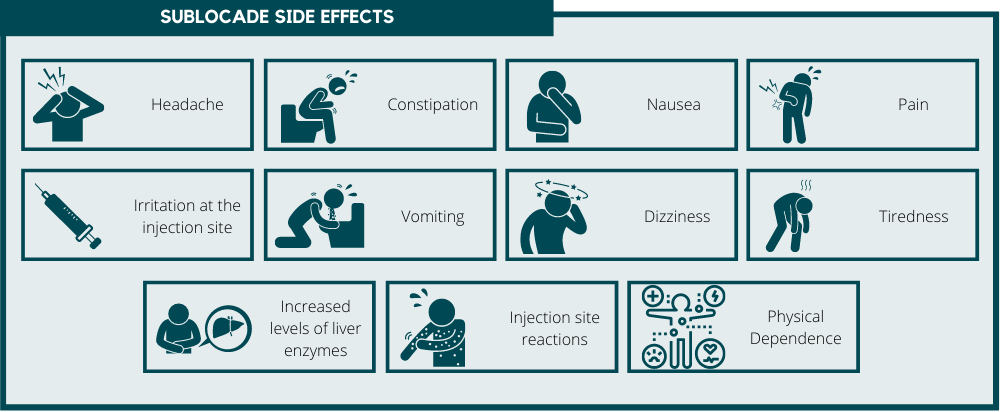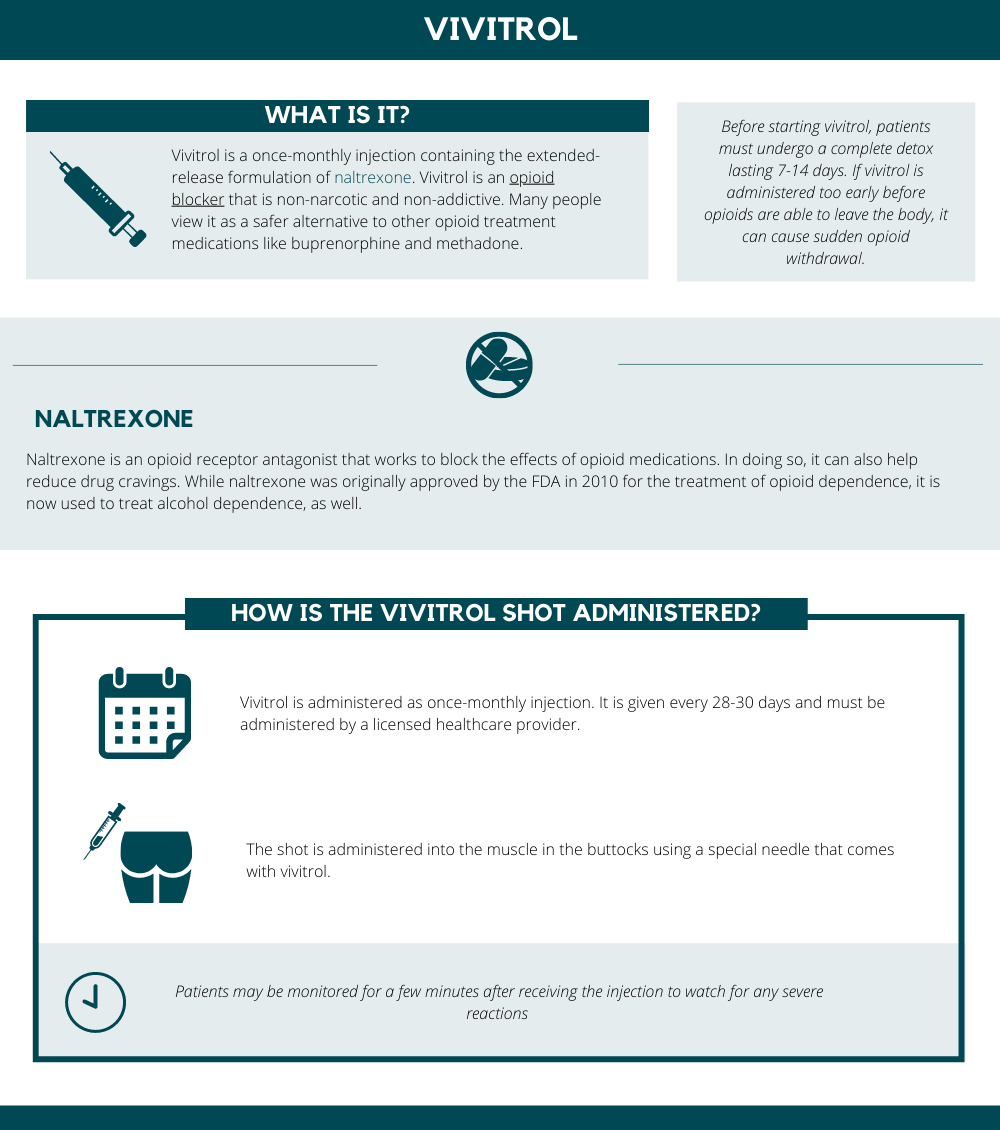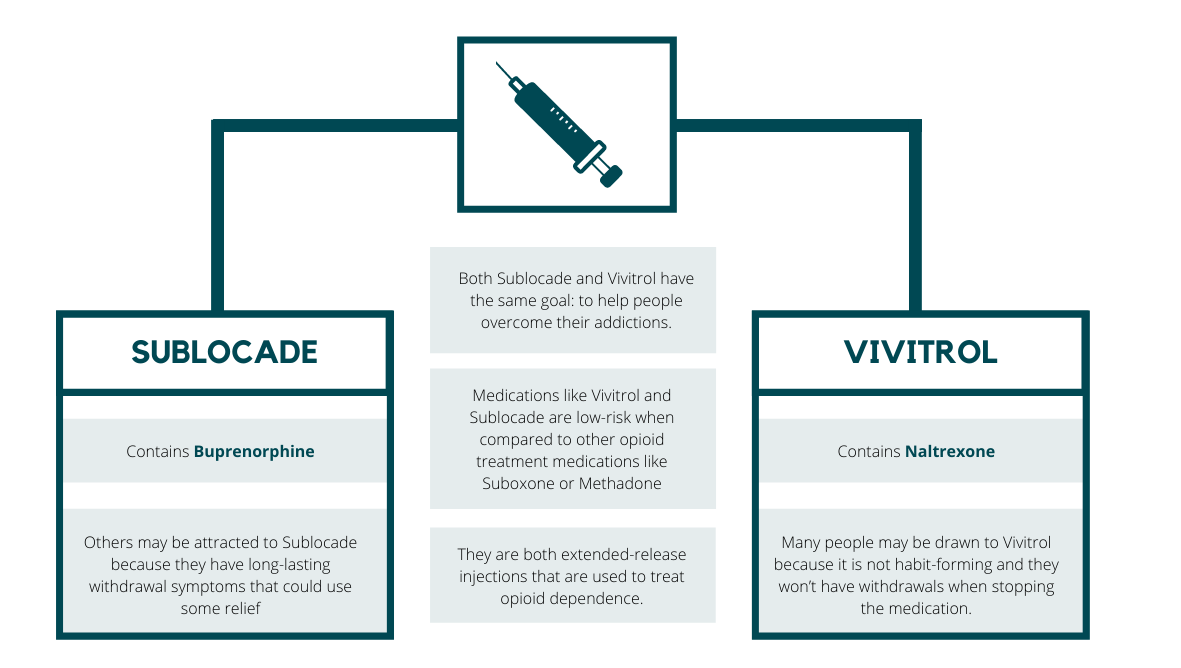
14 May Vivitrol vs. Sublocade: An Opioid Treatment Medication Comparison
Vivitrol and Sublocade have a lot in common. They are both extended-release injections that are used to treat opioid dependence. While both injections are administered in similar ways and for the same purpose, they are actually two very different medications. Vivitrol contains naltrexone while Sublocade contains buprenorphine. Buprenorphine and naltrexone belong to two very different drug classes, so they have different side effects and risks.
Patients who suffer from opioid addiction may enter into a medication-assisted treatment (MAT) program that utilizes opioid treatment medications like Sublocade and Vivitrol. Before deciding on a medication, it is important to understand how these medications work, what the potential side effects are, and how they differ from one another. Then, a doctor can help patients decide which medication is right for them.
What is Sublocade (Buprenorphine)?
Sublocade is a brand-name prescription medication that is approved by the FDA to treat moderate to severe opioid use disorder. Its active ingredient is an extended-release formulation of buprenorphine, a partial opioid agonist that binds to opioid receptors, activating them without producing euphoric effects. In doing so, buprenorphine helps treat opioid withdrawal and dependence by reducing withdrawal symptoms and drug cravings.[1]
Sublocade is usually used in patients who have previously used buprenorphine products. This is to ensure that the patient doesn’t have an allergic or adverse reaction to extended-release buprenorphine. The injection is given subcutaneously every 26 days. It comes in two strengths: 100 mg and 300 mg.
Sublocade is a Schedule III controlled substance, meaning it has a high potential for abuse. However, due to the high-risk potential, it is also highly regulated and administered under strict prescribing guidelines. Physicians must complete specialized training before being licensed to prescribe and administer Sublocade.
Buprenorphine has opioid-like properties, so it can be habit-forming. People who take Sublocade for several months may experience mild withdrawal symptoms when they stop taking their medication or miss a shot. While these symptoms are similar to those of opioid withdrawal, they are usually less severe and easily managed.
Sublocade Side Effects
The most common side effects reported by people taking Sublocade are mild and usually go away within a few days of the injection. These include headache, constipation, nausea, pain or irritation at the injection site, and vomiting. Other potential side effects of Sublocade include:

- Dizziness
- Tiredness
- Increased levels of liver enzymes
- Injection site reactions
- Physical dependence
When used properly and in combination with a comprehensive treatment program, Sublocade is a safe and effective medication.
What is Vivitrol (Naloxone)?
While Sublocade is used only to treat opioid dependence, Vivitrol is approved by the FDA to treat both opioid and alcohol abuse. Vivitrol is a once-monthly injection containing Naltrexone.
When it comes to treating opioid dependence, naltrexone works by reducing cravings for drugs. Naltrexone, being an opioid antagonist, also blocks the pleasurable effects produced by opioids, so people who are taking Vivitrol will be unable to feel the effects of opioids.
Vivitrol is administered intramuscularly into the buttocks every 28-30 days. It is only available in one dose of 380 mg. Patients must stop taking opioids at least 7 to 10 days before taking Vivitrol.[2]
Vivitrol is not classified as a controlled substance by the DEA. It doesn’t lead to addiction, is not habit-forming, and cannot produce a high. As a result, people do not experience withdrawal symptoms when they stop taking Vivitrol.

Vivitrol Side Effects
The most commonly reported side effect of the Vivitrol shot is pain, redness, swelling, or itching at the injection site. Usually, these reactions go away within a few days. Other common side effects include:

- Stomach pain
- Muscle cramps
- Dizziness
- Fatigue
- Decreased appetite
- Anxiety
- Headache
- Joint stiffness
- Nausea
- Vomiting
- Diarrhea
Sublocade vs. Vivitrol: An Overview

Both Sublocade and Vivitrol have the same goal: to help people overcome their addictions. The primary difference between these two substances is the medication they contain. Many people may be drawn to Vivitrol because it is not habit-forming and they won’t have withdrawals when stopping the medication. On the other hand, others may be attracted to Sublocade because they have long-lasting withdrawal symptoms that could use some relief.
In the end, the only way to know whether or not a medication is right is to speak with a doctor and try it out. Medications like Vivitrol and Sublocade are low-risk when compared to other opioid treatment medications like Suboxone or Methadone, and can be highly effective at helping people stay sober.
Both medications should be used in combination with a treatment program that involves behavioral therapy and peer support. And, when compared to patients not taking any opioid treatment medications, both Sublocade and Vivitrol perform very well in terms of helping patients stay sober.
Medical Support and Therapy at Florida Recovery Group
Here at Florida Recovery Group, our medical staff addresses the chemical imbalances and additional issues that affect patients who are recovering from addiction. Our doctors may prescribe medications like Vivitrol or Sublocade based on a person’s individual needs. As a truly medically integrated facility, Florida Recovery Group works in partnership with MDs, ARNP’s, Psychiatrists, Clinicians, and case managers to help our clients heal and succeed.
To learn more about our opioid treatment program in Delray Beach, give us a call today.
References:





